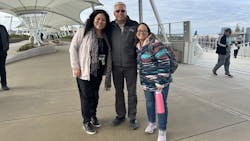OahuMPO delegation tours Seattle TOD for hands-on project planning, delivery training
Members from the Honolulu Department of Housing and Land Management (DHLM)’s Finance Division participated in the Oahu Metropolitan Planning Organization (OahuMPO) Project Management Training Mobile Workshop in Seattle, Wash., serving as a capstone for OahuMPO’s project management training program. The department says the workshop offered a hands-on opportunity to observe how federally funded transportation projects are planned, delivered and integrated into growing communities.
Over several days, the DHLM team toured various transit-oriented development (TOD) implementations in the greater Seattle region, meeting with state and local project managers, planners, engineers and nonprofit housing organizations involved in the development.
“Seeing how other cities coordinate early and consistently across transportation, housing and planning was extremely valuable,” said DHLM Executive Assistant Jennifer Ontai. “It gave us practical insight into how we can continue strengthening our own interagency work as we plan communities that are accessible, connected and supportive of families.”
The department says the workshop showcased how beginning with coordination between transit and land use planning can improve outcomes for both mobility and housing in the projects. In Seattle, participants saw how transportation agencies, planning departments and housing organizations worked together from project inception through completion to align infrastructure investments, zoning decisions and community priorities. The DHLM team observed how this coordinated approach to development and permitting contributed to the development of mixed-use, pedestrian-friendly areas around transit stations, with housing opportunities located near jobs, services and public amenities.
“The multi-modal tour of Seattle and its surrounding areas was an inspiring experience,” said DHLM Finance Division Planner Ailina Laborte. “It showcased how integrated transit, walkability and community-centered planning can truly shape vibrant, connected neighborhoods. I was inspired by how agencies across the region worked together to overcome challenges and deliver results. Their dedication to ensuring residents can get to work and to other community destinations shows what collaboration can achieve.”
The department notes that the trip also highlighted how public-private and public–nonprofit partnerships can aid in the delivery of affordable housing near public transit. The DHLM team says tools they saw used, such as targeted incentive zoning, eased parking requirements and expedited project review, posed effective in supporting the long-term financial feasibility of TOD projects while advancing affordability goals.
Another key takeaway the team highlighted was Seattle’s use of data to help in the consideration of mobility, safety and equity outcomes. By analyzing how people move through and use transit-oriented neighborhoods, Seattle showcased how it’s been able to make informed decisions that improve access and community benefit over time. The DHLM team identified opportunities to explore similar data-driven evaluation tools in Honolulu to support future TOD decision-making and interagency coordination.
The department says the lessons the team gained from the mobile workshop will help inform ongoing interdepartmental efforts on Oʻahu, particularly in the team’s work to support transit-oriented redevelopment around the future Kūwili Station in Iwilei. By coordinating land use, housing and transportation planning early in the process—and by exploring partnership models that support mixed-income housing near transit—the city says it can advance TOD projects that are cohesive, equitable and reflective of community priorities.
As Honolulu continues to invest in its rail infrastructure, the insights gained through this training will help shape strategies that promote connected, livable neighborhoods and expand access to housing near transit for residents across generations.
